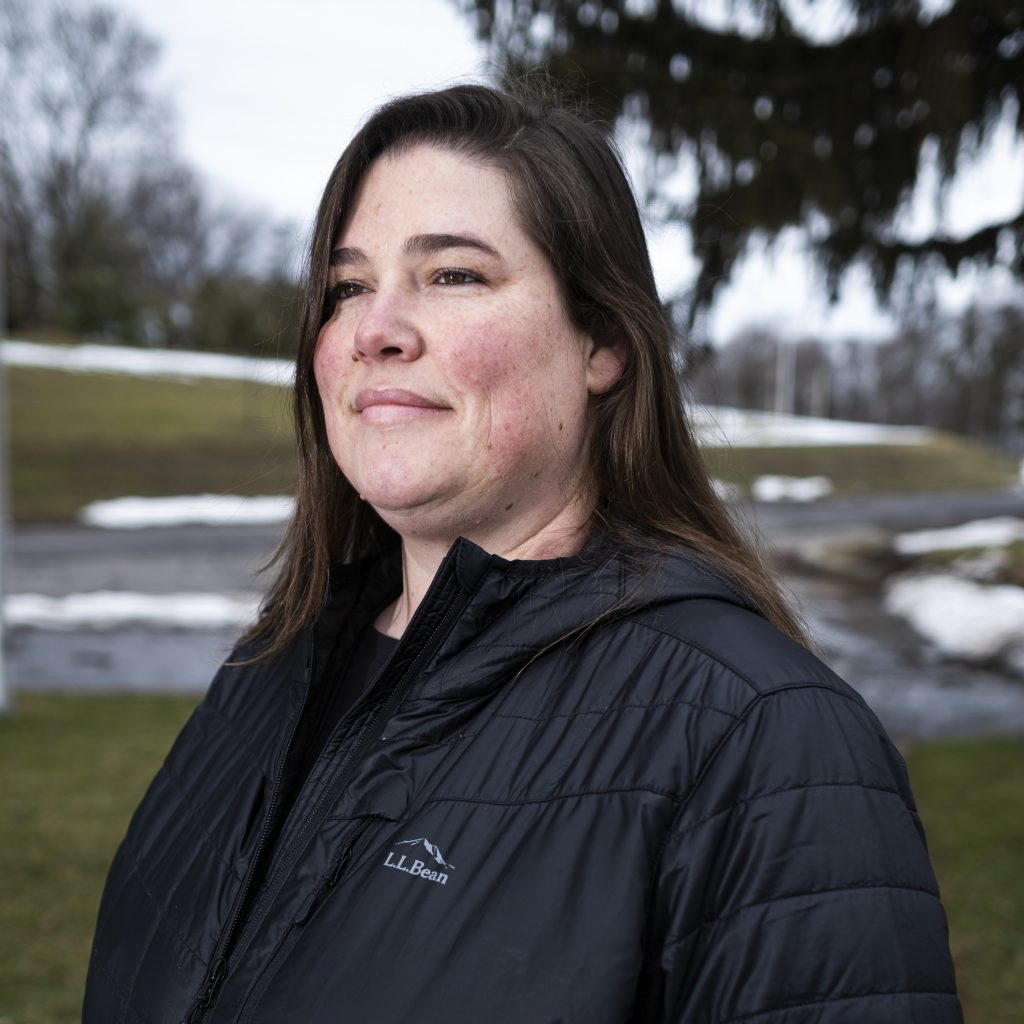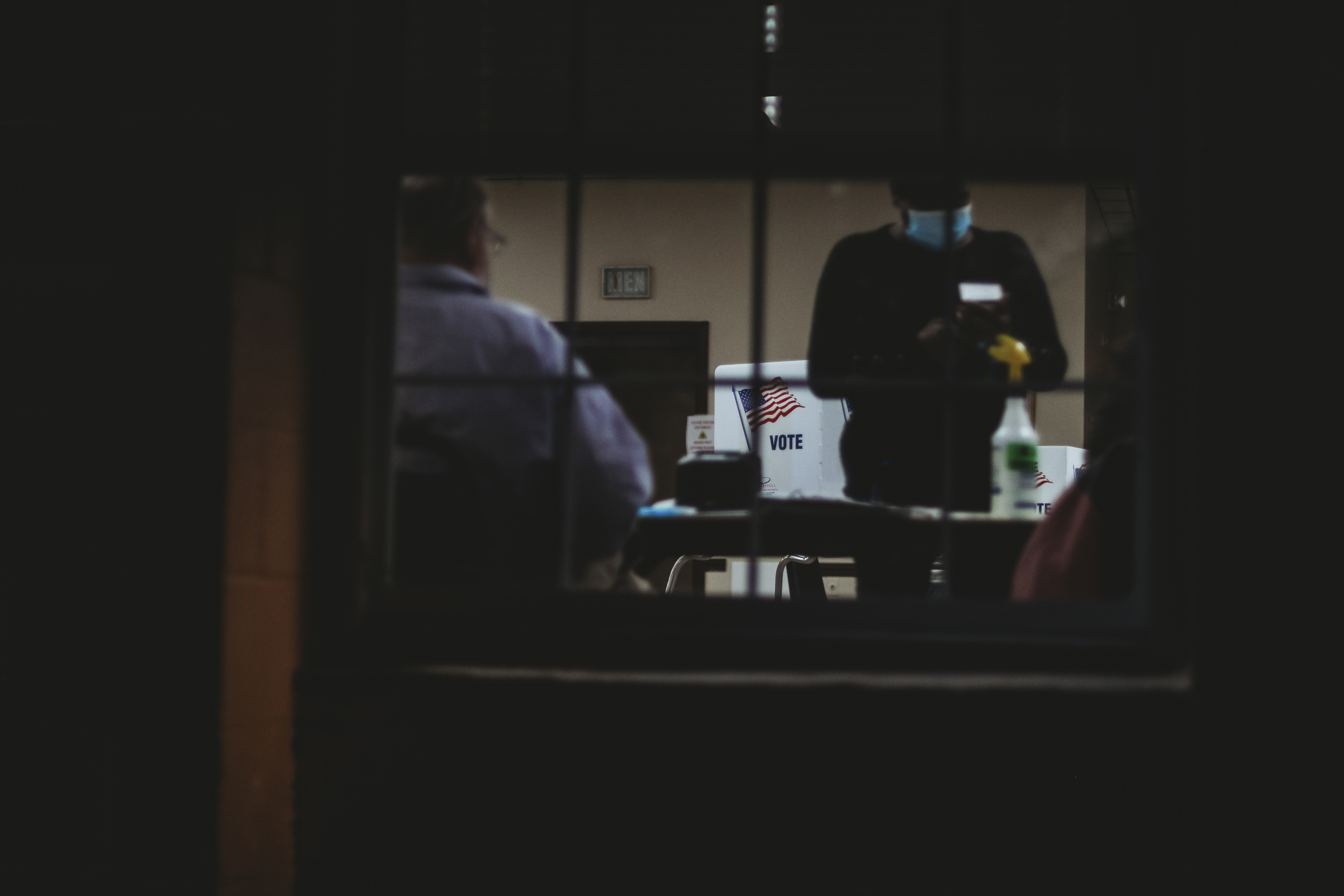Voting in Silence
Voting in Silence
Deaf and hard of hearing voters must overcome many obstacles to exercise their right to vote.

indsay Ryan stands in a long line, spaced six feet from those waiting in front and behind her.
She’s not bothered by the line at the Hillside Work Scholarship Connection gym in Syracuse. It’s Election Day, and she’s eager to cast her ballot.
Ryan’s eagerness then turns to anxiety as poll workers instruct voters to move along. She sees the gesturing, but she hears nothing.
A woman walks up to Ryan, a mask hiding her lips. Is she talking? Ryan can’t tell. The silence that envelops Ryan wherever she goes seems to grow even deeper.
Ryan pulls out her phone, opens an application, and starts typing. In an extra-large font, she writes that she is deaf and shows the message to the poll worker.
Ryan’s anxiety subsides when the woman reacts in comprehension.
“No wonder,” the poll worker says. “Deaf.”
Now at the front of the line, Ryan sees that the poll worker who helped her earlier is distracted. Her uncertainty wells up again.
Many Deaf and hard of hearing people struggle to learn about candidates and then exercise their right to vote. More than 8.5 million Americans are classified as having “Hearing Difficulty,” which includes those who are deaf or have serious difficulty hearing, 2018 U.S. Census data shows. Between 2010 and 2018, the Deaf voted at about the same rate as other Americans. Deaf voter registrations increased nearly 20% in that same timeframe, while Deaf voter turnout increased 33% in the eight-year span, the census reports.

But advocates and members of the community say more Deaf and hard of hearing people would vote if the system better accommodated Deaf citizens.
“How many are gonna bother doing this?” Ryan said of other Deaf people. “Or they don’t understand the process of it? Mailing in the ballot, they don’t want to deal with it because it’s not so accessible. So, I bet you a million bucks how many Deaf people didn’t vote because of accessibility.”
Like Ryan, many other hard-of-hearing voters find the voting process confusing. Poll workers aren’t prepared to communicate, interpreters aren’t available, and the language on the ballot is hard to understand for those who communicate primarily with American Sign Language. With a pandemic raging, rampant systemic inequities, and a struggling economy, a vote is a lifeline — if you can understand how to cast it.
Yet the mechanics of voting are relatively simple compared to the broader challenge for the Deaf to engage in meaningful political discourse with other Americans, or even to access basic information about the candidates. Deaf and hard of hearing voters could also be dissuaded from voting because of their limited options to engage in the political debate.
A Deaf-owned consulting firm polled 100 Deaf, hard of hearing, and Deaf-Blind people in 2017 and found that 72% would not vote for a candidate that does not caption their videos. The option to make campaign content accessible is entirely up to a candidate.
There are laws in place to protect a Deaf or hard of hearing person’s right to vote, but there is no law protecting their right to political information, according to Michael Schwartz, director of the Syracuse University Disability Rights Clinic.
“The law protects everyone’s right to vote, deaf or not,” Schwartz, who is deaf, wrote in an email. “Does it ensure fair access to political information? No, it does not.”
A crucial part of the electoral process is understanding information about candidates to decide who to vote for. The arbitrary availability of political information makes that process challenging for Deaf voters.
2020 marked the 30-year anniversary of the Americans with Disabilities Act. Access to the polls is protected by this law, but the mandate is vague.
“The ADA protects deaf people’s right to effective communication access in the voting booth,” Schwartz said. “What that really means is that when a deaf voter goes to the polls, poll workers need to be ready to communicate effectively.”
Ryan’s experience confirms that poll accessibility is inconsistent.

Polls aren’t required to provide interpreters. Having written instructions is not foolproof, because English is not the native language for some Deaf people. American Sign Language is not a direct translation from English and it has its own grammar rules, which can make reading written English a more tedious process for this electorate. Others don’t know ASL, because there is a range of different sign languages used across the globe.
There is a misconception on what access for the Deaf means. The chaotic first presidential debate between Donald Trump and Joe Biden sparked a debate on TikTok on whether captioning is a suitable alternative to having an ASL interpreter on the TV broadcast.
“Subtitles don’t work, they’re really delayed,” 19-year-old Erin Rosenfeld said in a viral TikTok. “It’s not accessible. It’s not equal access and it’s not right.”
Many in the Deaf community agree that both sign language interpretation and captioning are necessary to appropriately include the Deaf in politics and civic life. Some may prefer one over the other or need to draw from both for full comprehension.
The choice can vary from person to person and can depend on whether someone is culturally Deaf or not, according to the National Association of the Deaf.
Howard A. Rosenblum, the CEO of the National Association of the Deaf, said the biggest challenges for Deaf voters are communication barriers, which can include instructions, ballot language, and political information accessibility, among other issues.
“The deaf or hard of hearing voter is often confused and lost — especially if it is their first time voting,” Rosenblum said in an email. “Anything that is aurally conveyed should be equally accessible for others that do not understand in that way.”
Barriers to Voting
Despite many obstacles to obtaining candidate information and voting, more Deaf and hard of hearing citizens have registered – and turned out – to vote since 2010.
Many political events are now held via streaming services that lack closed captioning. Kate Corbett Pollack, an SU Disability Cultural Center coordinator, said the quality of captioning can also be a problem, especially with live events.
“I think a good analogy for able-bodied people might be straining your eyes for a long time,” she wrote on captioning of the State of the Union in 2016.
The National Association of the Deaf said the Commission on Presidential Debates will provide interpreters for those in the audience who request one. But this excludes the vast majority of Deaf voters who watch on television or online. Independent organizations offer interpretation, like the Deaf Professional Arts Network, which provided ASL interpretation for the presidential debates on their website. While helpful to people like Ryan who have internet access, it excludes those who don’t.
“Such debates often are fast-paced and real-time captioning technology is often pushed to the limits during these debates, and accuracy suffers as a result,” Rosenblum said. “Moreover, the language used during these debates are typically advanced, especially at such a fast pace. With ASL access, deaf and hard of hearing viewers would be able to follow the pace in their native language and are able to arrive at a well-educated decision on how they want to vote.”
The extent to which a candidate makes their campaign accessible sways some voters. Michael Mazzaroppi, an SU disability access counselor who identifies as culturally Deaf and hard of hearing, said access greatly influences his decision of who to vote for.
“Four years ago, when there were ad campaigns going on TV, there was one that was captioned and that stuck with me and I remember I voted for him,” Mazzaroppi said.
Pollack, who identifies as culturally Deaf, said she considers a candidate’s platform in addition to how they interact with the Deaf community.
“If a candidate had deaf access, but a platform I did not at all agree with, it would not really matter if they had access,” she wrote in an email. “But usually someone who has deaf and disability access will share some of my political views in other areas, because they are thinking of inclusion and diversity.”
Ryan said she is focusing on pushing for system changes to bridge these gaps in access for the Deaf.
“We all live on the same planet so we all should have accessibility to equal rights,” Ryan said.
Although the ADA made strides for the disability community in the last three decades, the system is still failing many in a country that prides itself on being a democratic leader — despite valuing some voters over others.
“Without equal access to the same information that everyone else gets,” Rosenblum said, “deaf and hard of hearing voters are left behind.”

